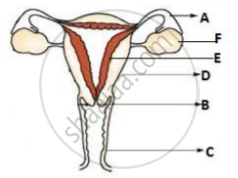Advertisements
Advertisements
प्रश्न
How is juvenile phase different from reproductive phase?
उत्तर
| Juvenile phase | Reproduction phase |
| Juvenile phase is the period of growth between the birth of an organism and before its reproductive maturity. | The reproductive phase is the period of growth after juvenile phase when an individual attain reproductive maturity and reproduces. |
संबंधित प्रश्न
Name two main processes of sexual reproduction
What are the advantages of sexual reproduction over asexual reproduction?
Define Reproductive phase
Describe the process of fertilisation in human beings.
Give two differences between a zygote and a foetus.
List any four steps involved in sexual reproduction .
Name two animals which reproduce sexually.
Write the various steps involved in the sexual reproduction in plants.
The offsprings formed as a result of sexual reproduction exhibit more variations because ______
Distinguish between the following pair of terms:
Sexual reproduction and asexual reproduction.
Multiple choice question. Tick (✓) the correct choice:
Which of the following glands is responsible for bringing about changes during adolescence in boys and girls?
- pituitary
- adrenal
- thyroid
- testis
Differentiate between the following:
Sperm and Ovum
Define the term Adolescence.
Describe the different methods of asexual reproduction in animals.
What is sexual reproduction? List its four significances.
In the sexual mode of reproduction, greater diversities are generated.
How is the chromosome number maintained in sexually reproducing organisms?
Answer in one sentence.
Name the endocrine glands involved in maintaining the sex characteristics of males.
Long answer question.
Describe female reproductive system of human.
Describe the histology of testis with help of labelled diagram.
Identify the labels from the given diagram.

Which are the components of pollination?
Identify the INCORRECT statement.
Match column -1 with column - II and select the correct option.
| Column - I | Column - II | ||
| 1. | Seminal vesicles | a. | Membranous urethra |
| 2. | Scrotum | b. | Thermoregulatory |
| 3. | Tunica vaginalis | c. | Fibro muscular pouches |
| 4. | Cowper's gland | d. | Peritoneal covering |
Choose the correct statements from the options below:
A few statements with regard to sexual reproduction are given below:
- Sexual reproduction does not always require two individuals
- Sexual reproduction generally involves gametic fusion
- Meiosis never occurs during sexual reproduction
- External fertilisation is a rule during sexual reproduction
Oestrus cycle is seen in ______.
______ lay thousands and sometimes millions of small, soft eggs in water.
What is external fertilisation?
In telolecithal egg, the yolk is found:
Rose plants produce large, attractive bisexual flowers but they seldom produce fruits. On the other hand a tomato plant produces plenty of fruits though they have small flowers. Analyse the reasons for failure of fruit formation in rose.
Both these plants - rose and tomato - both selected by human beings for different characteristics, the rose for its flower and tomato for its fruit. Roses, being vegetatively propagated do not need to produce seeds.
